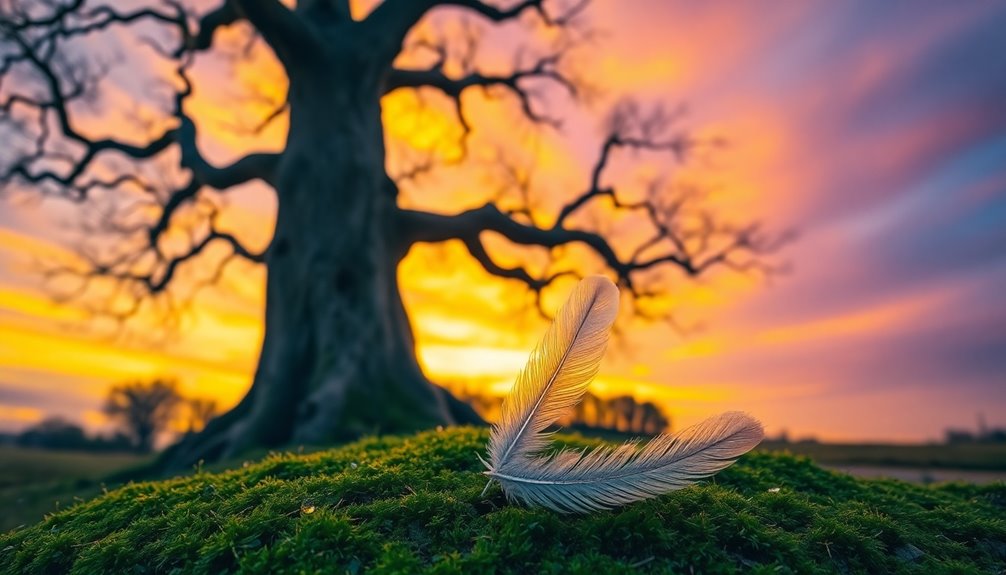Symbolism is a fantastic way stories show deeper meanings! It uses objects, characters, or even colors to represent bigger ideas. For example, a red rose often stands for love, while a dove represents peace. In literature, the green light in "The Great Gatsby" symbolizes hope and dreams. You see, symbolism enriches stories and makes them more exciting by adding layers of meaning. It can really change how you feel about a story as you find these hidden messages. So, keep exploring, and you'll discover even more amazing symbols and what they really mean!
Key Takeaways
- Symbolism involves using objects or elements to represent deeper meanings beyond their literal sense in literature.
- An example of symbolism is the green light in "The Great Gatsby," symbolizing unattainable dreams and hope.
- Red roses are commonly used as symbols of love and romance in various literary works.
- The letter "A" in "The Scarlet Letter" represents sin and resilience, showcasing the power of symbols to convey complex ideas.
- Analyzing symbols enhances understanding of themes and character journeys within a story, enriching the reading experience.
Understanding Symbolism in Literature

Symbolism plays an essential role in literature, allowing you to uncover deeper meanings behind objects, characters, and events. Authors use symbolism as a powerful literary device to add layers to their stories. For instance, the color red is a common symbol that often signifies passion or anger. When you see red in a story, it can spark strong emotions and help you connect with the characters.
Understanding symbolism means examining the context in which these symbols appear. Their meanings can change as the story unfolds. A great example of symbolism is found in F. Scott Fitzgerald's *The Great Gatsby*. The green light symbolizes Gatsby's hope and his dreams that seem just out of reach.
Metaphors also play a big part in understanding symbolism. They help draw comparisons between different ideas without using "like" or "as," creating a richer experience for you as a reader.
Types of Symbolism

As you explore the layers of meaning in literature, you'll encounter various types of symbolism that enhance your understanding of the text. One type is metaphors, which compare two different things to convey deeper meanings. For example, saying "Time is a thief" suggests that time steals precious moments.
Another type is allegories; these are extended metaphors throughout a story. George Orwell's "Animal Farm" is a great example, where farm animals represent political figures.
You'll also find romantic symbolism, where objects like roses symbolize love and passion. This highlights how certain physical objects carry emotional weight.
Then, there's emotional symbolism, which uses colors to evoke feelings. For instance, red can represent anger or passion, while blue might bring calmness and tranquility.
Finally, physical object symbolism involves tangible items that represent abstract concepts, like a dove representing peace or a chain symbolizing bondage. Each of these types of symbolism helps authors convey complex ideas and emotions.
Common Symbols and Their Meanings

Throughout literature and everyday life, certain symbols pop up repeatedly, each carrying its own unique meaning. For example, red roses symbolize love and romance. When you give a red rose, it often represents deep affection.
Similarly, rainbows are commonly associated with hope and promise, representing the idea of new beginnings after a storm.
Doves, frequently used in art and literature, are recognized as a symbol of peace. They convey messages of harmony and tranquility.
On the other hand, skulls can symbolize mortality, serving as a reminder of life's fleeting nature. You might see them in stories to represent the inevitability of death.
Keys are another interesting symbol that often represents access and freedom. They signify revealing new opportunities and potential in life.
These are just a few common types of symbolism you'll encounter. Each one is used to symbolize something deeper, carrying a meaning beyond its literal sense.
Understanding these symbols can add layers of joy and excitement to your reading experience. So, the next time you spot these symbols, you'll appreciate what they truly represent!
Examples of Symbolism in Texts

Understanding the meanings behind common symbols enriches your reading experience, making it easier to recognize their deeper significance in various texts.
For instance, in F. Scott Fitzgerald's "The Great Gatsby," the green light symbolizes Gatsby's unattainable dreams and hope for the future. This simple light represents big ideas about desire and ambition.
In Nathaniel Hawthorne's "The Scarlet Letter," the letter "A" worn by Hester Prynne shows both her sin of adultery and her strength in facing judgment. It's a powerful symbol of resilience.
Shakespeare's "Macbeth" uses blood to symbolize guilt, haunting characters like Macbeth and Lady Macbeth with their irreversible actions.
In George Orwell's "Animal Farm," the pig Napoleon represents the corrupting influence of power. It highlights the betrayal of revolutionary ideals.
Lastly, John Steinbeck's "Of Mice and Men" features Candy's dog as a symbol of how society views individuals seen as useless or weak.
These examples of symbolism in literature help you connect with the characters and ideas authors want to convey. Recognizing these symbols makes reading even more enjoyable and meaningful!
Analyzing Symbolism for Deeper Insight

To plunge into analyzing symbolism effectively, you'll want to look beyond the surface. Start by identifying different symbols in a story. Each symbol represents something bigger, like emotions or themes. Understanding the context helps you see how a symbol might change meaning based on the story's setting.
Here's a quick table to help you think about symbols:
| Symbol | Represents Something | Context Impact |
|---|---|---|
| Color Red | Passion or Anger | Cultural meanings vary |
| A Broken Mirror | Reflection of Self | Can show internal struggles |
| Recurring Birds | Freedom or Escape | Changes with character growth |
When you spot recurring symbols, they can reveal deeper insights into characters and their journeys. It's exciting to see how the author's intention can blend with your interpretation. This mix creates a rich tapestry of meanings!
Frequently Asked Questions
What Is Symbolism 3 Examples?
Symbolism is when objects or characters stand for bigger ideas. For instance, in *The Great Gatsby*, the green light shows Gatsby's hopes and dreams.
In *The Scarlet Letter*, the letter "A" represents Hester's shame but grows to symbolize her strength.
Finally, in *Animal Farm*, the animals represent different social classes and critique society's flaws.
These examples reveal how symbols add depth to stories, making them more meaningful and exciting for readers like you!
What Are 5 Examples of Symbolism in Sentences?
You'll find symbolism everywhere in literature, adding deeper meaning to stories!
For instance, in *The Great Gatsby*, the green light represents Gatsby's dreams.
In *Animal Farm*, the farm itself shows the rise of communism.
Hester Prynne's letter "A" in *The Scarlet Letter* symbolizes her sin and strength.
The conch shell in *Lord of the Flies* stands for order among the boys.
Finally, in Keats' poem, the nightingale shows beauty's fleeting nature.
Isn't that exciting?
What Is Symbols and Example?
Symbols are special objects or images that stand for bigger ideas or feelings. For instance, a red rose often means love, while a black cat might make you think of bad luck.
These symbols help stories feel deeper and more exciting! When you see a green light in a story, it could represent hope or dreams.
What Is an Easy Example of Symbolism in Literature?
Imagine a bright green light shining across a dark bay. In literature, that light can symbolize hope, dreams, or even something just out of reach.
For example, in F. Scott Fitzgerald's *The Great Gatsby*, it represents Gatsby's longing for a future filled with love and success.
This simple yet powerful image helps you understand the character's deepest desires and makes the story come alive in your imagination!
Conclusion
To sum up, symbolism lights up our stories like stars in the night sky. When you spot a symbol, remember it can reveal deeper meanings, just like the ring in "The Lord of the Rings." So, as you read, keep an eye out for these hidden treasures! They make your journey through literature exciting and full of surprises. Immerse yourself, explore, and let symbolism guide you to new discoveries in every book you open!











